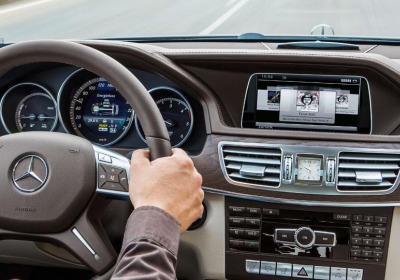New NHTSA guidelines recommend vehicle systems disable text entry, videos while driving
Tue, 23 Apr 2013
Federal regulators, moving to curb distracted driving, issued final voluntary safety guidelines today that would disable certain in-vehicle functions such as manual texting, Web browsing and video phoning while driving.
Automakers should do more to keep drivers' eyes on the road and hands on the wheel, U.S. auto regulators said as they released the latest guidelines meant to cut down on crashes caused by the use of electronic devices in cars.
The National Highway Traffic Safety Administration specifically recommended disabling several operations unless a vehicle is stopped and in park:
• Manual text entry for the purposes of text messaging and internet browsing;
• Video-based entertainment and communications such as video phoning or video conferencing; and
• Displaying certain types of text, including text messages, Web pages, and social-media content.
The final guidelines issued today by NHTSA are voluntary, not binding, for the industry. Still, they pose a challenge to car companies that have invested heavily in electronics and software to let drivers perform more and more tasks from behind the wheel.
'The safety we all need'
"There's no doubt that drivers appreciate these technologies, but we've got an obligation to balance the innovations consumers want with the safety we all need," outgoing Transportation Secretary Ray LaHood told reporters during a phone call today as NHTSA announced the standards.
The guidelines, which NHTSA first proposed in February 2012, include a 12-second limit on the length of time that a driver should need to take eyes off the road to perform a task, such as changing the radio station, turning on air conditioning or answering a phone call using a car's built-in hands-free software.
That is less than the 20 seconds allowed by the voluntary industry guidelines set by the Alliance of Automobile Manufacturers, the largest trade group for the industry in the United States.
Car companies have acknowledged the risk posed by distracted driving, though they criticized some aspects of NHTSA's proposal.
Built-in vs. cell phones
As the agency mulled its proposal, industry lobbyists argued that overly restrictive limits for built-in devices could make car companies' built-in new features less useful and cause drivers to use the same functions on cell phones instead.
NHTSA has said that after finishing its guidelines for in-car equipment, it intends to set guidelines for portable devices and for voice-activated features.
Automakers were measured today in their response to the final rules, saying they needed time to review the final NHTSA guidelines.
"Our members have already factored in many of the recommendations in the draft NHTSA guidelines for in-vehicle devices in their internal design processes," said Michael Stanton, president of the Association of Global Automakers, which includes Toyota, Honda and Hyundai, in a statement.
The final guidelines that the agency released today will be phased in over three years, allowing automakers to retool electronic navigation and entertainment systems in order to comply.
Read more here: http://www.star-telegram.com/2013/04/23/4797004/us-expected-to-seek-limits-on.html#storylink=cpyIt may be the last major initiative on auto safety by LaHood, who has said he will step down once a replacement can be confirmed. LaHood has made the campaign against distracted driving one of his signature issues, pushing for bans on handheld cell phone use in all 50 states.It may be the last major initiative on auto safety by LaHood, who has said he will step down once a replacement can be confirmed. LaHood has made the campaign against distracted driving one of his signature issues, pushing for bans on handheld cell phone use in all 50 states.
The agency will consider including the distraction guidelines in its New Car Assessment Program, which is used to devise the government's five-star safety ratings system for light vehicles, Strickland told reporters.
Such a move would also give automakers an incentive to comply with the guidelines.
The agency recently announced that it will take comment on a number of changes to the ratings.
According to NHTSA data, 3,331 people died in distracted-driving accidents in 2011, up from 3,092 in 2010. Another 387,000 people were injured in 2011 in crashes involving a distracted driver, vs. 416,000 in 2010.
Three years
The final guidelines that the agency released today will be phased in over three years.
It may be the final major step taken on auto safety by LaHood, who has said he will step down once a replacement can be confirmed. LaHood has made the campaign against distracted driving one of his signature issues, pushing for bans on handheld cell phone use in all 50 states.
According to NHTSA data, 3,331 people died in distracted-driving accidents in 2011, up from 3,092 in 2010. Another 387,000 people were injured in 2011 in crashes involving a distracted driver, vs. 416,000 in 2010.
Changes made
Automakers persuaded NHTSA to make a number of changes to its proposal.
General Motors and other companies had criticized certain guidelines as too specific. In comments submitted to NHTSA in October, GM said that certain requirements, such as a cap of 30 characters on messages displayed to drivers, would be "very limiting and not necessary."
In the final rule, NHTSA scrapped the 30-character limit. Instead, the agency recommended that car companies disable the ability to display any amount of text from books, periodicals or web pages while a car is moving, NHTSA Administrator David Strickland told reporters.
Comments from automakers also said the proposed guidelines could discourage automakers from offering helpful navigation features.
The agency's suggested limits on "dynamic displays" were meant to prevent vehicle displays from showing videos, but GM and other car companies contended they could block the use of dynamic maps with the ability to show, for instance, that a traffic jam is ahead.
Strickland told reporters today that the agency decided those types of features were acceptable.
(NHTSA recommends disabling built-in texting, Web browsing originally appeared on Automotive News, sub. req.)
By Gabe Nelson- Automotive News

